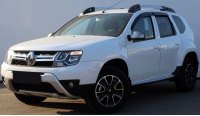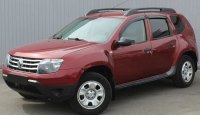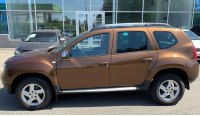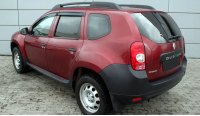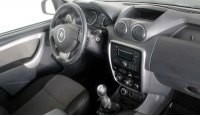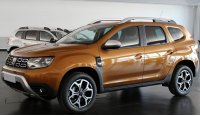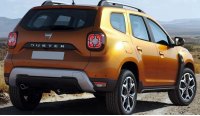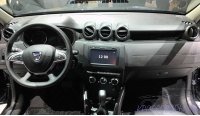Share with friends:
The main competitors and classmates are currently the following cars from other automakers - BMW X1, Citroen C-Crosser, Chery Tiggo, Chevrolet Captiva, Chevrolet Niva, Ford Kuga, Great Wall Hover, Honda CR-V, Hyundai Tucson, Kia Sportage, Lada 4x4 Vision, Land Rover Freelander, LIFAN Myway, Mazda CX-5, Mitsubishi Outlander, Mercedes-Benz GLK-Class, Nissan Qashqai, Opel Antara, Peugeot 4008, Renault Koleos, Skoda Kodiaq, SsangYong Actyon, Suzuki SX4, Subaru Forester, Toyota RAV4 and Volkswagen Tiguan.
First generation (2009-2017)
The first generation was presented in November 2009 at the French National Ice Races «Andros Trophy», as well as in December 2009, the car was shown to the press. At the Geneva Motor Show in March 2010, the Duster was presented to the public. Platform based «B0», which is an extended modification of the platform «Nissan B». This platform is used for cars «Renault»: «Logan», «Sandero», «Kaptur», «Duster»; others brands: «Dacia Lodgy», «Dacia Dokker», «LADA Largus» And «LADA XRAY», as well as many cars of the company «Nissan». The body was basically a five-door station wagon with a wheelbase of 2673 mm, a length of 4315 mm, a width of 1822 mm, a height of 1630-1690 mm and a curb weight of 1160-1294 kg. There was also a four-door pickup truck with a wheelbase of 2829 mm and an overall length of 4700 mm.
The engine was located in front transversely with front-wheel drive or all-wheel drive technology «Nissan». The line of four-cylinder gasoline engines looked like this:
- 1.2 liters (1197 cm3, H5Ft, turbo) 123 hp
- 1.6 liters (1598 cm3, K4M) 103 hp (petrol), 113 HP (ethanol) and 101 hp (gas)
- 2.0 liters (1998 cm3, F4R) 133 hp (petrol) and 139 hp (ethanol)
The diesel engine was a single four-cylinder turbocharged 1.5 liter (1461 cm3, K9K, SOHC) 84, 106 and 109 hp. The transmission was a six- or five-speed manual, a four- or six-speed automatic, and a continuously variable variator «X-Tronic».
The car is equipped with anti-lock braking system (ABS) with electronic brake force distribution (EBD) and emergency braking system (EBA). Optional electronic stability control (ESC), understeer control (CSV) and traction control (ASR). Two airbags are installed in the front on all models, and side airbags for the head and chest are additionally installed as an option. In 2011, Duster tested the European Committee «Euro NCAP» to determine its safety and awarded it only three stars out of five. The low rating was due to the lack of a top speed limiter and the lack of electronic stability control as standard.
The updated car was presented at the Frankfurt Motor Show in September 2013. A chrome grille and updated headlights appeared at the front, the changes were minor at the rear, and the interior was also updated.
The production of the first generation Renault Duster was carried out in Brazil, India, Indonesia, Colombia, Russia and Romania. In total, more than 2 million cars were produced. In India, the production of the first generation will continue until 2023, when it should be replaced by the third generation.
Second generation (2017-present time)
The second generation Duster was officially introduced in August 2017 and was shown in September 2017 at the Frankfurt Motor Show, with sales beginning in November. Based on the same platform «B0», like the first generation. Body in the form of a five-door station wagon with five seats. The length of the car is 4320 mm, width 1820 mm, height 1630-1700 mm, wheelbase 2673 mm and curb weight 1160-1294 kg. Exterior design and interior design is completely updated. Halved the noise in the cabin, but because of this, the volume of the trunk has decreased. The power steering has been replaced with an electric power steering. The engine is located transversely in front, the drive is full or only on the front wheels. There were four trim levels - basic «Duster», «Essential», «Comfort» And «Prestige».
At first, engines were installed from the first generation, but then from the summer of 2018 they were updated. Currently, gasoline engines have the following characteristics - 1.2 liters «TCe» (1197 cm3, H5FT, turbo, 125 hp), 1.3 liters «TKe» (1333 cm3, turbo, 130 and 150 hp) and 1.6 liters «SCe» (1598 cm3, H4M, 115 hp). 1.5 liter turbocharged diesel engine (1461 cm3, K9K) — «dCi» 90/110 hp. And «Blue dCi» 95/115 hp. The transmission is a six- or five-speed manual or a six-speed dual-clutch automatic «DCT».
The car is equipped with a system of four video cameras «MultiView», automatic climate control, blind spot warning, daytime running lights and keyless entry and ignition as standard. Hill start assist and hill descent assist are also offered.
In December 2017 the European Committee «EuroNCAP» published the crash test results of the second generation Duster model. It received three stars out of five, although most competitors received five stars.

